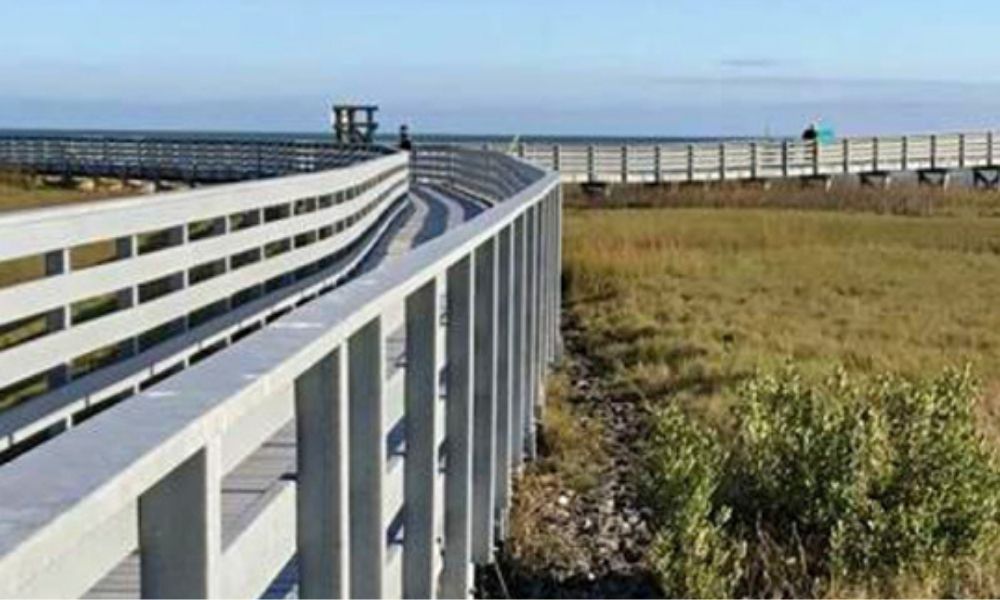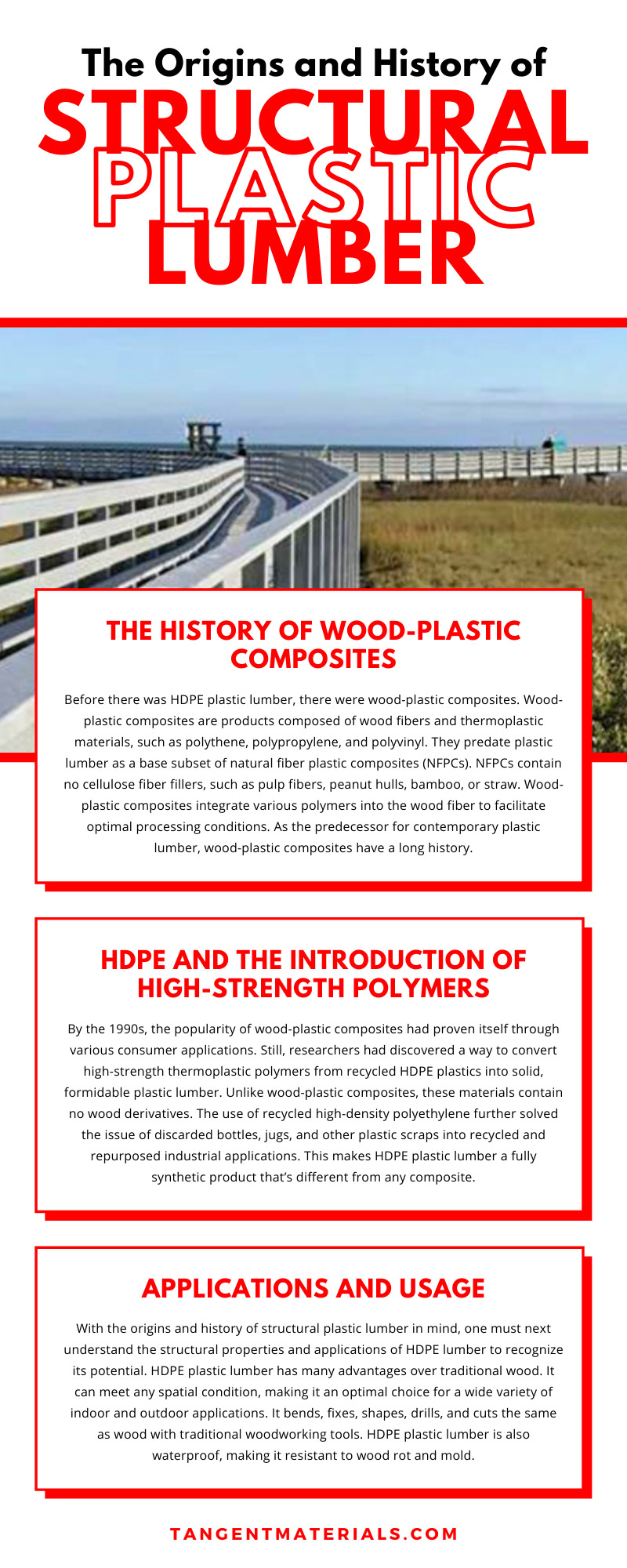The Origins and History of Structural Plastic Lumber

Plastic lumber has become one of the most widely used structural materials today. With exceptional strength, durability, and versatility, it poses an unmatched rival to traditional wood. Still, it’s important to see how plastic material came to be with the origins and history of structural plastic lumber. From the original wood-plastic composites of the 20th century to today’s high-density polyethylene materials, plastic lumber has made significant strides in residential, commercial, industrial, and marine applications. Read this guide to learn more about the history of plastic lumber and its uniqueness compared to traditional wood.
The History of Wood-Plastic Composites
Before there was HDPE plastic lumber, there were wood-plastic composites. Wood-plastic composites are products composed of wood fibers and thermoplastic materials, such as polythene, polypropylene, and polyvinyl. They predate plastic lumber as a base subset of natural fiber plastic composites (NFPCs). NFPCs contain no cellulose fiber fillers, such as pulp fibers, peanut hulls, bamboo, or straw. Wood-plastic composites integrate various polymers into the wood fiber to facilitate optimal processing conditions. As the predecessor for contemporary plastic lumber, wood-plastic composites have a long history.
It was first invented in 1960 in northern Italy in the city of Milan. Originally marketed as Plastic-Wood, this was the first main composite mixture of wood fiber and thermoplastic. From there, it’s seen a wide variety of applications in residential, commercial, and marine settings. WPCs are used for outdoor decks, siding, molding and trim, window and door frames, and furniture. Given that wood-plastic composites still retain wood fiber or flour, they may require preservatives to protect against wood rot and termite infestation.
HDPE and the Introduction of High-Strength Polymers
By the 1990s, the popularity of wood-plastic composites had proven itself through various consumer applications. Still, researchers had discovered a way to convert high-strength thermoplastic polymers from recycled HDPE plastics into solid, formidable plastic lumber. Unlike wood-plastic composites, these materials contain no wood derivatives. The use of recycled high-density polyethylene further solved the issue of discarded bottles, jugs, and other plastic scraps into recycled and repurposed industrial applications. This makes HDPE plastic lumber a fully synthetic product that’s different from any composite.
Since its introduction in the 1990s, synthetic lumber has proven reliable in many residential, commercial, and industrial applications. HDPE plastic lumber became popular with furniture builders due to the longevity and structural maintenance of the material. Additionally, bridges, pilings, and other marine engineering projects have utilized HDPE plastic lumber due to its natural moisture and weather resistance. The demand for plastic lumber has only increased in the present decade. The push to reduce post-consumer waste has generated new interest in HDPE lumber because of its sustainability. Not only is HDPE lumber created from post-consumer raw materials, such as milk jugs or bottles, but it’s also 100 percent recyclable after its intended use.
Applications and Usage
With the origins and history of structural plastic lumber in mind, one must next understand the structural properties and applications of HDPE lumber to recognize its potential. HDPE plastic lumber has many advantages over traditional wood. It can meet any spatial condition, making it an optimal choice for a wide variety of indoor and outdoor applications. It bends, fixes, shapes, drills, and cuts the same as wood with traditional woodworking tools. HDPE plastic lumber is also waterproof, making it resistant to wood rot and mold.
The low maintenance also proves a reliable facet. The high-strength thermoplastic polymers make it resistant to a wide range of chemical agents and preserve paint and finish without needing much upkeep. You can paint and finish your HDPE plastic lumber using natural tones to provide a wood-like finish.
Despite these advantages, it’s worth noting that even HDPE plastic lumber has its disadvantages. Mainly, extreme weather can alter the lumber’s quality. Extremely hot weather, for example, may warp it. Plastic lumber also creeps more than wood in terms of engineering properties. With compressive properties equal or greater than wood, there’s little modulus of elasticity, thus causing creepage and load-bearing issues.
There are various standards to keep in mind with plastic lumber properties. The American Society for Testing and Materials lists seven standards used for plastic lumber applications.
- D 6108 Standard Test Method for Compressive Properties of Plastic Lumber and Shapes
- D 6109 Standard Test Method for Flexural Properties of Unreinforced and Reinforced Plastic Lumber
- D 6111 Standard Test Method for Bulk Density and Specific Gravity of Plastic Lumber and Shapes by Displacement
- D 6112 Standard Test Methods for Compressive and Flexural Creep and Creep-Rupture of Plastic Lumber and Shapes
- D 6117 Standard Test Methods for Mechanical Fasteners in Plastic Lumber and Shapes
- D 6341 Standard Test Method for Determination of the Linear Coefficient of Thermal Expansion of Plastic Lumber and Plastic Lumber Shapes between -30 and 140-degrees Fahrenheit
- D 6435 Standard Test Method for Shear Properties of Plastic Lumber and Plastic Lumber Shapes
Manufacturers use these ratings to determine the strength and prospects of plastic lumber for various applications. These applications range from residential to commercial, industrial, and marine-grade projects. Some common applications for plastic lumber include decking, flooring, railings, fencing, landscaping, cladding and siding, molding and trim, window and door frames, marine walls and piling, and more. The range of applications makes HDPE plastic lumber a reliable and versatile structural material for many industries thanks to its low-maintenance and natural resistance to moisture, heat, and environmental conditions.
Tangent Materials is the ultimate solution for finding structural plastic lumber for contractors, government agencies, homeowner associations, corporations, and architects. Tangent’s alternative materials offer environmental protection against heat, moisture, and insect infestation, so you don’t need to worry. Our plastic lumber is engineered according to your specific needs and requirements. With exceptional strength, durability, easy maintenance and upkeep, and color stability, you save significantly more time and money using plastic lumber over traditional wood. These products are also environmentally friendly. Either recycle your plastic lumber or send it back to us, and we’ll repurpose it for future use. Tangent Materials sells affordable HDPE plastic lumber for a wide range of purposes. Call now to learn more or order your molded, continuously extruded, or marine decking or timber today.













